Study on the Corrosion Behavior of Low-Carbon 9Cr-ODS Steel in Oxygen-Saturated Lead–Bismuth Eutectic for 1000 Hours
Abstract
1. Introduction
2. Materials and Methods
2.1. Materials
2.2. Corrosion Test
2.3. Microstructure Characterization
3. Results
4. Discussion
4.1. Oxidation Mechanism of the OOL and IOL
4.2. Oxidation Mechanism of IOZ
5. Conclusions
- After 1000 h of corrosion at 500 °C, three distinct layers of oxide film were formed on the substrate’s surface: an Fe3O4 layer infiltrating the LBE, a dense FeCr2O4 layer, and an IOZ layer arranged from outside to inside.
- The formation of the Fe3O4 and FeCr2O4 layers is attributed to the diffusion of Fe. The outward diffusion of Fe leads to the growth of the Fe3O4 layer, while the inward diffusion of O results in the formation of the FeCr2O4 layer.
- The IOZ primarily consists of unoxidized matrix and Cr2O3, exhibiting two morphologies: one porous, and the other non-porous.
- The predominant oxide in the IOZ is Cr2O3. This is attributed to the dense oxide film, which reduces the O content near the substrate and preferentially facilitates the formation of Gibbs free energy associated with low Cr2O3.
Author Contributions
Funding
Data Availability Statement
Acknowledgments
Conflicts of Interest
References
- Buckthorpe, D. Introduction to Generation IV nuclear reactors. In Structural Materials for Generation IV Nuclear Reactors; Woodhead Publishing: Sawston, UK, 2017; pp. 1–22. [Google Scholar]
- Aitkaliyeva, A.; He, L.; Wen, H.; Miller, B.; Bai, X.M.; Allen, T. 7—Irradiation effects in Generation IV nuclear reactor materials. In Structural Materials for Generation IV Nuclear Reactors; Yvon, P., Ed.; Woodhead Publishing: Sawston, UK, 2017; pp. 253–283. [Google Scholar]
- Abram, T.; Ion, S. Generation-IV nuclear power: A review of the state of the science. Energy Policy 2008, 36, 4323–4330. [Google Scholar] [CrossRef]
- Zhang, J. A review of steel corrosion by liquid lead and lead–bismuth. Corros. Sci. 2009, 51, 1207–1227. [Google Scholar] [CrossRef]
- Ballinger, R.G.; Lim, J. An overview of corrosion issues for the design and operation of high-temperature lead- and lead-bismuth-cooled reactor systems. Nucl. Technol. 2004, 147, 418–435. [Google Scholar] [CrossRef]
- Zhang, J.; Li, N. Review of the studies on fundamental issues in LBE corrosion. J. Nucl. Mater. 2008, 373, 351–377. [Google Scholar] [CrossRef]
- Lu, C.; Lu, Z.; Wang, X.; Xie, R.; Li, Z.; Higgins, M.; Liu, C.; Gao, F.; Wang, L. Enhanced Radiation-tolerant Oxide Dispersion Strengthened Steel and its Microstructure Evolution under Helium-implantation and Heavy-ion Irradiation. Sci. Rep. 2017, 7, 40343. [Google Scholar] [CrossRef]
- Ukai, S.; Ohtsuka, S.; Kaito, T.; de Carlan, Y.; Ribis, J.; Malaplate, J. 10—Oxide dispersion-strengthened/ferrite-martensite steels as core materials for Generation IV nuclear reactors. In Structural Materials for Generation IV Nuclear Reactors; Yvon, P., Ed.; Woodhead Publishing: Sawston, UK, 2017; pp. 357–414. [Google Scholar]
- Xu, H.; Lu, Z.; Wang, D.; Liu, C. Microstructure Refinement and Strengthening Mechanisms of a 9Cr Oxide Dispersion Strengthened Steel by Zirconium Addition. Nucl. Eng. Technol. 2017, 49, 178–188. [Google Scholar] [CrossRef]
- Fazio, C.; Balbaud, F. 2—Corrosion phenomena induced by liquid metals in Generation IV reactors. In Structural Materials for Generation IV Nuclear Reactors; Yvon, P., Ed.; Woodhead Publishing: Sawston, UK, 2017; pp. 23–74. [Google Scholar]
- Zhang, J.; Li, Y.; Wang, G.; Bao, F.; Rui, X.; Shi, Q.; Yan, W.; Shan, Y.; Yang, K. Effects of Heat Treatment on Microstructure and Mechanical Properties of a Bimodal Grain Ultra-Low Carbon 9Cr-ODS Steel. Acta Metall. Sin. 2022, 58, 623–636. [Google Scholar]
- Zhang, J.; Li, Y.; Rui, X.; Yan, W.; Silver, A.; Yang, K. Study on microstructure and mechanical properties of 9Cr-ODS steel prepared by powder hot forging. J. Iron Steel Res. 2021, 33, 8. [Google Scholar]
- Grybėnas, A.; Makarevičius, V.; Baltušnikas, A.; Lukošiūtė, I.; Kriūkienė, R. Correlation between structural changes of M23C6 carbide and mechanical behaviour of P91 steel after thermal aging. Mater. Sci. Eng. A 2017, 696, 453–460. [Google Scholar] [CrossRef]
- Aghajani, A.; Somsen, C.; Eggeler, G. On the effect of long-term creep on the microstructure of a 12% chromium tempered martensite ferritic steel. Acta Mater. 2009, 57, 5093–5106. [Google Scholar] [CrossRef]
- Abe, F. Precipitate design for creep strengthening of 9% Cr tempered martensitic steel for ultra-supercritical power plants. Technol. Adv. Mater. 2008, 9, 013002. [Google Scholar] [CrossRef]
- Kimura, K.; Toda, Y.; Kushima, H.; Sawada, K. Creep strength of high chromium steel with ferrite matrix. Int. J. Press. Vessels Pip. 2010, 87, 282–288. [Google Scholar] [CrossRef]
- Xu, Y.; Yun, D.; Yan, X.; Zhang, P.; Yan, W.; Li, Y.; Li, C.; Li, J.; Zhang, T.; Li, J.; et al. Effects of Fe self-ion irradiation on a low carbon MX-ODS steel at 550 °C. Front. Energy Res. 2023, 10, 988745. [Google Scholar] [CrossRef]
- Tsisar, V.; Schroer, C.; Wedemeyer, O.; Skrypnik, A.; Konys, J. Long-term corrosion of austenitic steels in flowing LBE at 400 °C and 10−7 mass% dissolved oxygen in comparison with 450 and 550 °C. J. Nucl. Mater. 2016, 468, 305–312. [Google Scholar] [CrossRef]
- Müller, G.; Heinzel, A.; Konys, J.; Schumacher, G.; Weisenburger, A.; Zimmermann, F.; Engelko, V.; Rusanov, A.; Markov, V. Results of steel corrosion tests in flowing liquid Pb/Bi at 420–600 °C after 2000 h. J. Nucl. Mater. 2002, 301, 40–46. [Google Scholar] [CrossRef]
- Müller, G.; Heinzel, A.; Konys, J.; Schumacher, G.; Weisenburger, A.; Zimmermann, F.; Engelko, V.; Rusanov, A.; Markov, V. Behavior of steels in flowing liquid PbBi eutectic alloy at 420–600 °C after 4000–7200 h. J. Nucl. Mater. 2004, 335, 163–168. [Google Scholar] [CrossRef]
- Schroer, C.; Wedemeyer, O.; Novotny, J.; Skrypnik, A.; Konys, J. Selective leaching of nickel and chromium from Type 316 austenitic steel in oxygen-containing lead–bismuth eutectic (LBE). Corros. Sci. 2014, 84, 113–124. [Google Scholar] [CrossRef]
- Tian, S.J. Growth and Exfoliation Behavior of the Oxide Scale on 316L and T91 in Flowing Liquid Lead-Bismuth Eutectic at 480 °C. Oxid. Met. 2020, 93, 183–194. [Google Scholar] [CrossRef]
- Tsisar, V.; Schroer, C.; Wedemeyer, O.; Skrypnik, A.; Konys, J. Corrosion behavior of austenitic steels 1.4970, 316L and 1.4571 in flowing LBE at 450 and 550 °C with 10−7 mass% dissolved oxygen. J. Nucl. Mater. 2014, 454, 332–342. [Google Scholar] [CrossRef]
- Du, Q.; Chen, J.; Yun, D.; Gu, L.; Long, B.; Lu, C.; Li, Y.; Guo, S. Effect of post-annealing on the oxidation behavior of hot rolled ODS-FeCrAl steel in liquid lead. Corros. Sci. 2024, 228, 111815. [Google Scholar] [CrossRef]
- Zhu, Z.; Tan, J.; Zhang, Z.; Wu, X.; Li, J.; Wang, X.; Han, E.-H.; Ke, W. Corrosion behaviors of ODS-FeCrAl in oxygen-saturated lead-bismuth eutectic at 550 °C: Effects of grain boundaries and minor elements. J. Nucl. Mater. 2023, 587, 154710. [Google Scholar] [CrossRef]
- Martinelli, L.; Balbaud-Célérier, F.; Picard, G.; Santarini, G. Oxidation mechanism of a Fe-9Cr-1Mo steel by liquid Pb–Bi eutectic alloy (Part III). Corros. Sci. 2008, 50, 2549–2559. [Google Scholar] [CrossRef]
- Martinelli, L.; Balbaud-Célérier, F.; Terlain, A.; Bosonnet, S.; Picard, G.; Santarini, G. Oxidation mechanism of an Fe-9Cr-1Mo steel by liquid Pb–Bi eutectic alloy at 470 °C (Part II). Corros. Sci. 2008, 50, 2537–2548. [Google Scholar] [CrossRef]
- Martinelli, L.; Balbaud-Célérier, F.; Terlain, A.; Delpech, S.; Santarini, G.; Favergeon, J.; Moulin, G.; Tabarant, M.; Picard, G. Oxidation mechanism of a Fe–9Cr–1Mo steel by liquid Pb–Bi eutectic alloy (Part I). Corros. Sci. 2008, 50, 2523–2536. [Google Scholar] [CrossRef]
- Shi, Q.; Yan, W.; Li, Y.; Zhang, N.; Shan, Y.; Yang, K.; Abe, H. Oxidation behavior of ferritic/martensitic steels in flowing supercritical water. J. Mater. Sci. Technol. 2021, 64, 114–125. [Google Scholar] [CrossRef]
- Schroer, C.; Konys, J. Quantification of the Long-Term Performance of Steels T91 and 316L in Oxygen-Containing Flowing Lead-Bismuth Eutectic at 550 °C. J. Eng. Gas Turbines Power 2010, 132, 082901. [Google Scholar] [CrossRef]
- Xiao, J.; Gong, X.; Xiang, C.; Yu, Z.; Wang, H.; Zhao, K.; Liu, C.; Zhuo, H.; Qiu, S.; Yin, Y. A refined oxidation mechanism proposed for ferritic-martensitic steels exposed to oxygen-saturated liquid lead-bismuth eutectic at 400 °C for 500 h. J. Nucl. Mater. 2021, 549, 152852. [Google Scholar] [CrossRef]
- Zhao, Y.; Ding, S.; Du, Y.; Yang, K.; Liu, S. Effect of long-term thermal aging on lead-bismuth eutectic corrosion behavior of 9Cr ferritic/martensitic steel. J. Mater. Sci. Technol. 2025, 210, 299–311. [Google Scholar] [CrossRef]
- Yeliseyeva, O.; Tsisar, V.; Benamati, G. Influence of temperature on the interaction mode of T91 and AISI 316L steels with Pb–Bi melt saturated by oxygen. Corros. Sci. 2008, 50, 1672–1683. [Google Scholar] [CrossRef]
- Gong, X.; Short, M.P.; Auger, T.; Charalampopoulou, E.; Lambrinou, K. Environmental degradation of structural materials in liquid lead- and lead-bismuth eutectic-cooled reactors. Prog. Mater. Sci. 2022, 126, 100920. [Google Scholar] [CrossRef]
- Yang, C.; Xu, Y.; Yun, D.; Zhao, B.; Liu, W.; Gao, R.; Xie, S.; Qiu, J. Early corrosion behavior of low carbon 9Cr-ODS steel in high temperature oxygen-saturated lead-bismuth eutectic. Corros. Sci. 2024, 236, 112285. [Google Scholar] [CrossRef]
- Schroer, C.; Konys, J. Physical Chemistry of Corrosion and Oxygen Control in Liquid Lead and Lead-Bismuth Eutectic; Forschungszentrum Karlsruhe: Karlsruhe, Germany, 2007. [Google Scholar]
- Yamamoto, J.; Yoshino, T.; Yamazaki, D.; Higo, Y.; Tange, Y.; Torimoto, J. Thermal expansion of natural mantle spinel using in situ synchrotron X-ray powder diffraction. J. Mater. Sci. 2019, 54, 139–148. [Google Scholar] [CrossRef]
- Pilling, N.; Bedworth, R. The oxidation of metals at high temperatures. J. Inst. Met. 1923, 29, 529–582. [Google Scholar]
- Kubaschewski, O.; Hopkins, B.E. Oxidation of Metals and Alloys; Butterworths: Washington, DC, USA, 1962. [Google Scholar]
- Chen, K.; Zhang, L.; Shen, Z. Understanding the surface oxide evolution of T91 ferritic-martensitic steel in supercritical water through advanced characterization. Acta Mater. 2020, 194, 156–167. [Google Scholar] [CrossRef]
- Ye, Z.; Wang, P.; Dong, H.; Li, D.; Zhang, Y.; Li, Y. Oxidation mechanism of T91 steel in liquid lead-bismuth eutectic: With consideration of internal oxidation. Sci. Rep. 2016, 6, 35268. [Google Scholar] [CrossRef]
- Zhang, L.; Yan, W.; Shi, X.; Li, Y.; Shi, Q.; Shan, Y.; Yang, K.; Zheng, S. On oxidation film structure of SIMP steel exposed in stagnant oxygen-saturated LBE at 600 °C. Corros. Sci. 2024, 230, 111927. [Google Scholar] [CrossRef]
- Aerts, A.; Gavrilov, S.; Manfredi, G.; Marino, A.; Rosseel, K.; Lim, J. Oxygen-iron interaction in liquid lead-bismuth eutectic alloy. Phys. Chem. Chem. Phys. 2016, 18, 19526–19530. [Google Scholar] [CrossRef]
- Kolotinskii, D.; Nikolaev, V. Formation and Dissolution of Porous Magnetite Layer in Contact with Lead-Bismuth Eutectic: Locally Equilibrium Thermodynamic Model. Corros. Sci. 2023, preprint. [Google Scholar] [CrossRef]
- Müller, G.; Heinzel, A.; Schumacher, G.; Weisenburger, A. Control of oxygen concentration in liquid lead and lead–bismuth. J. Nucl. Mater. 2003, 321, 256–262. [Google Scholar] [CrossRef]
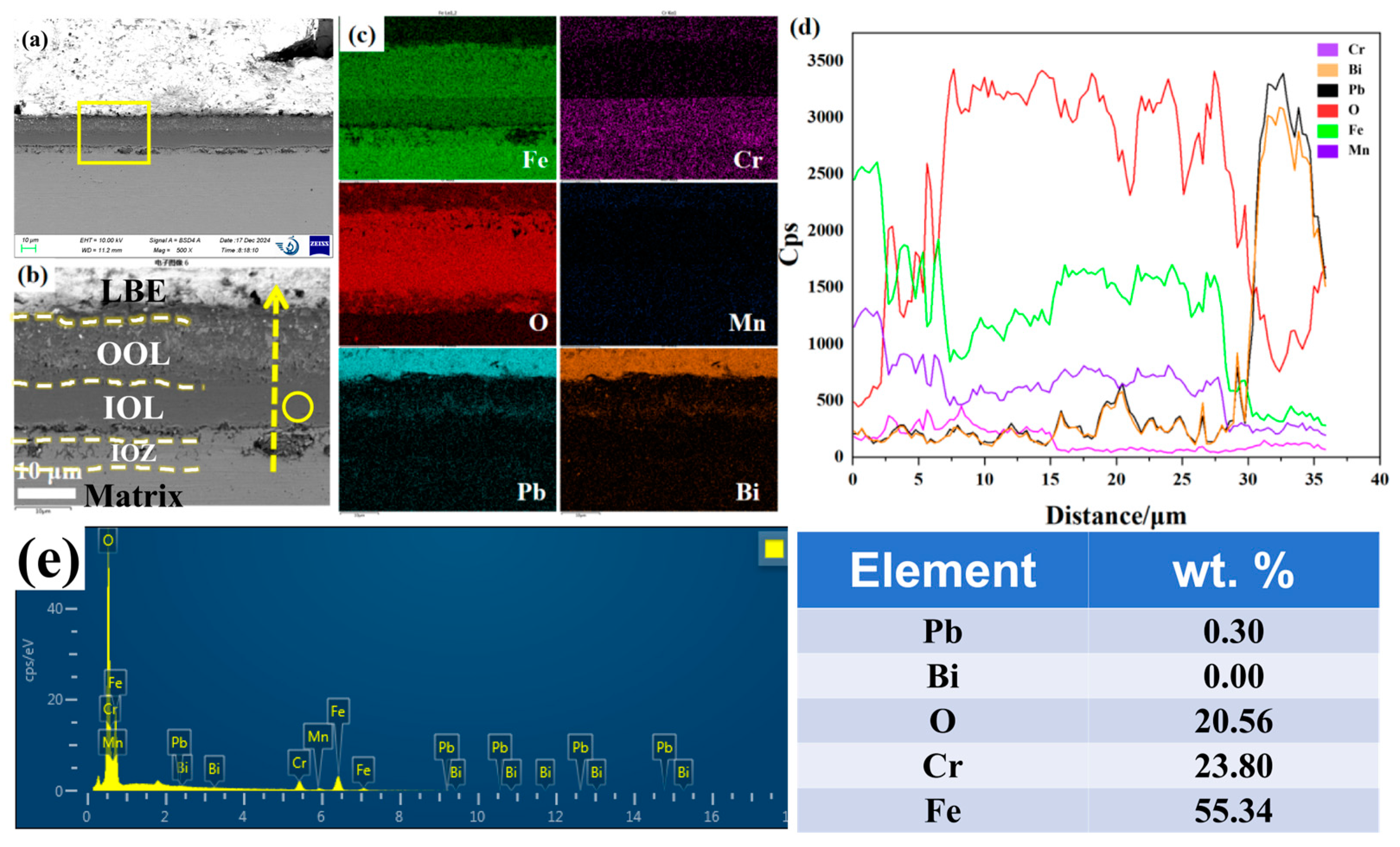
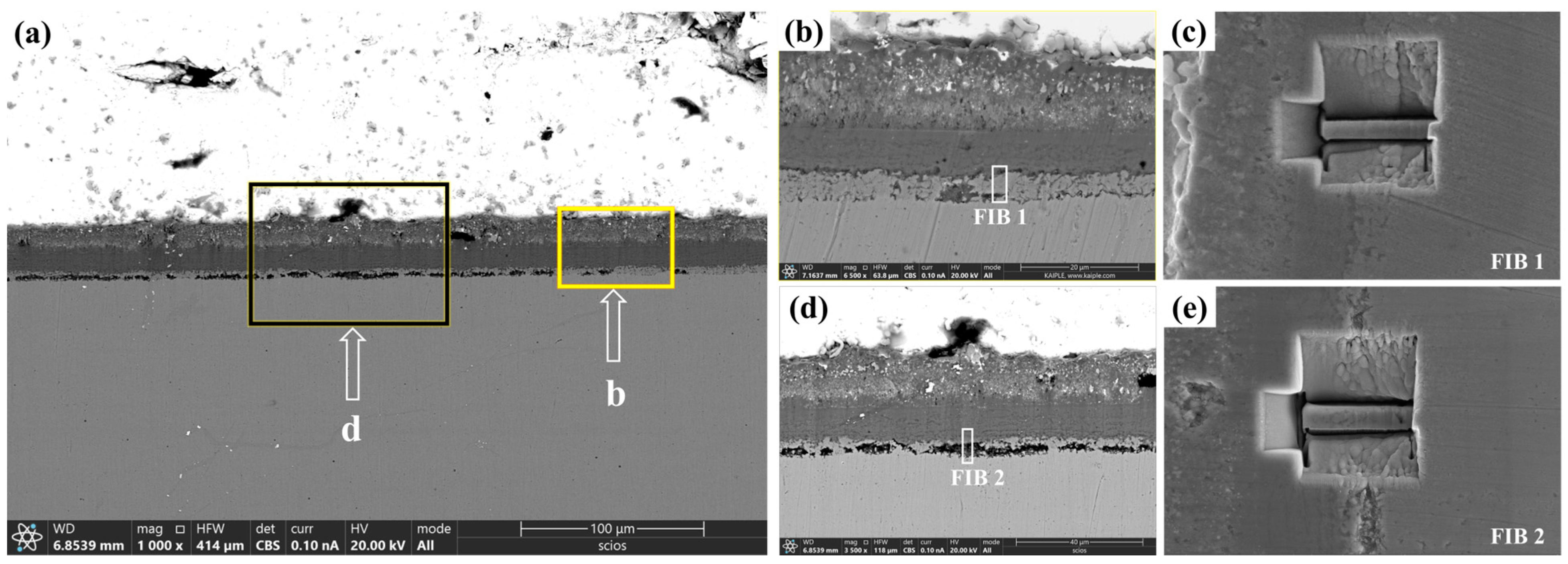
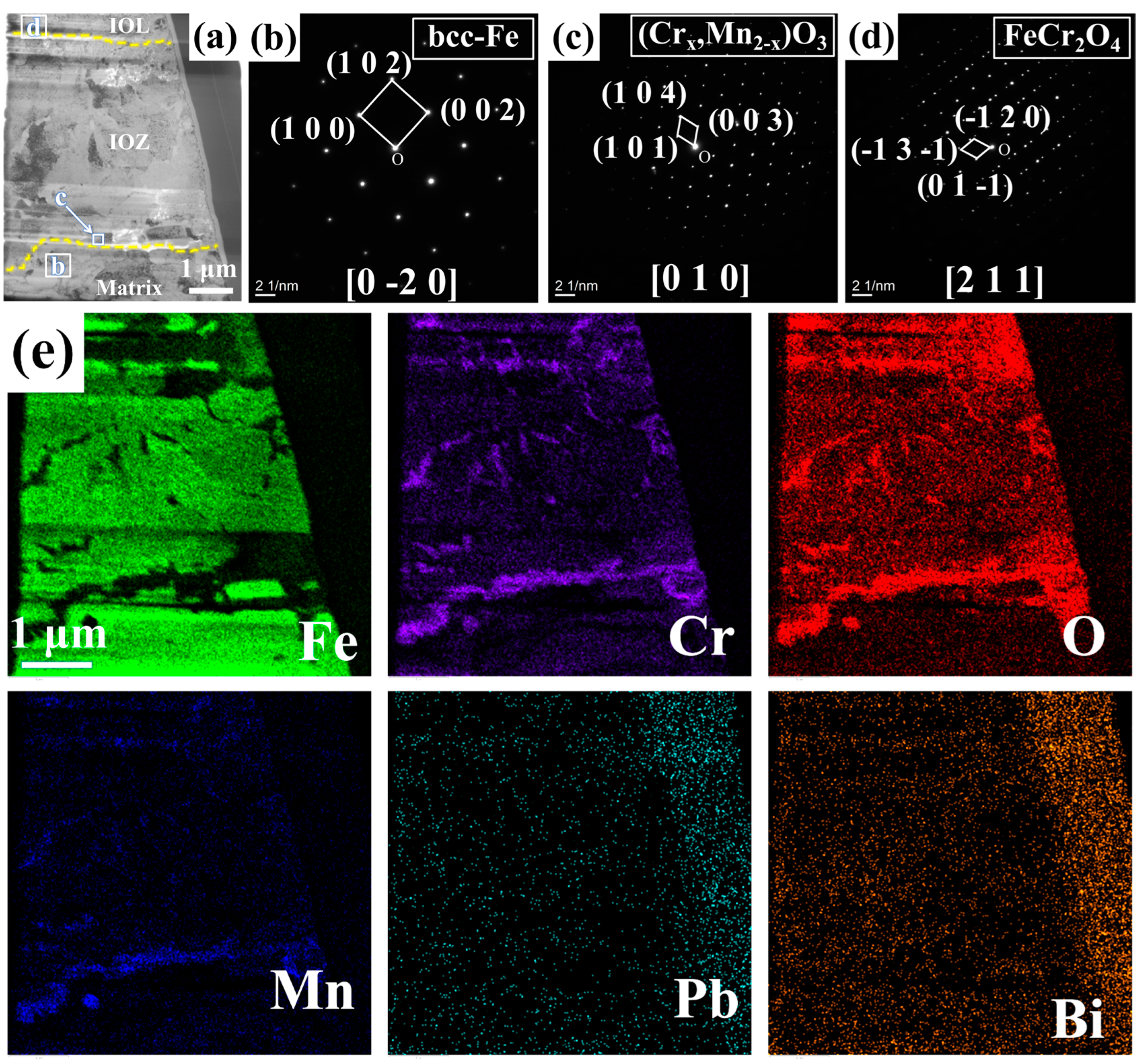
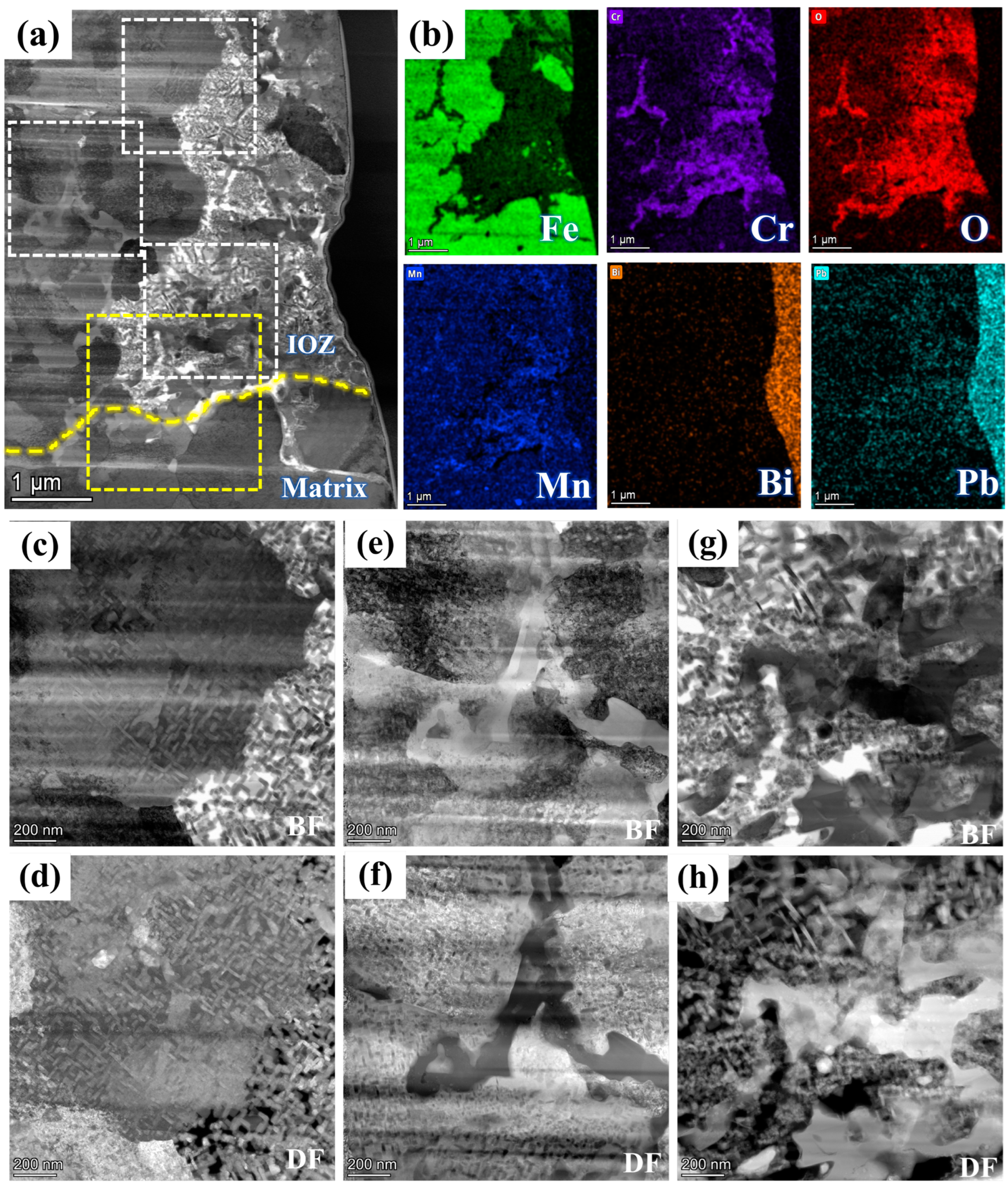
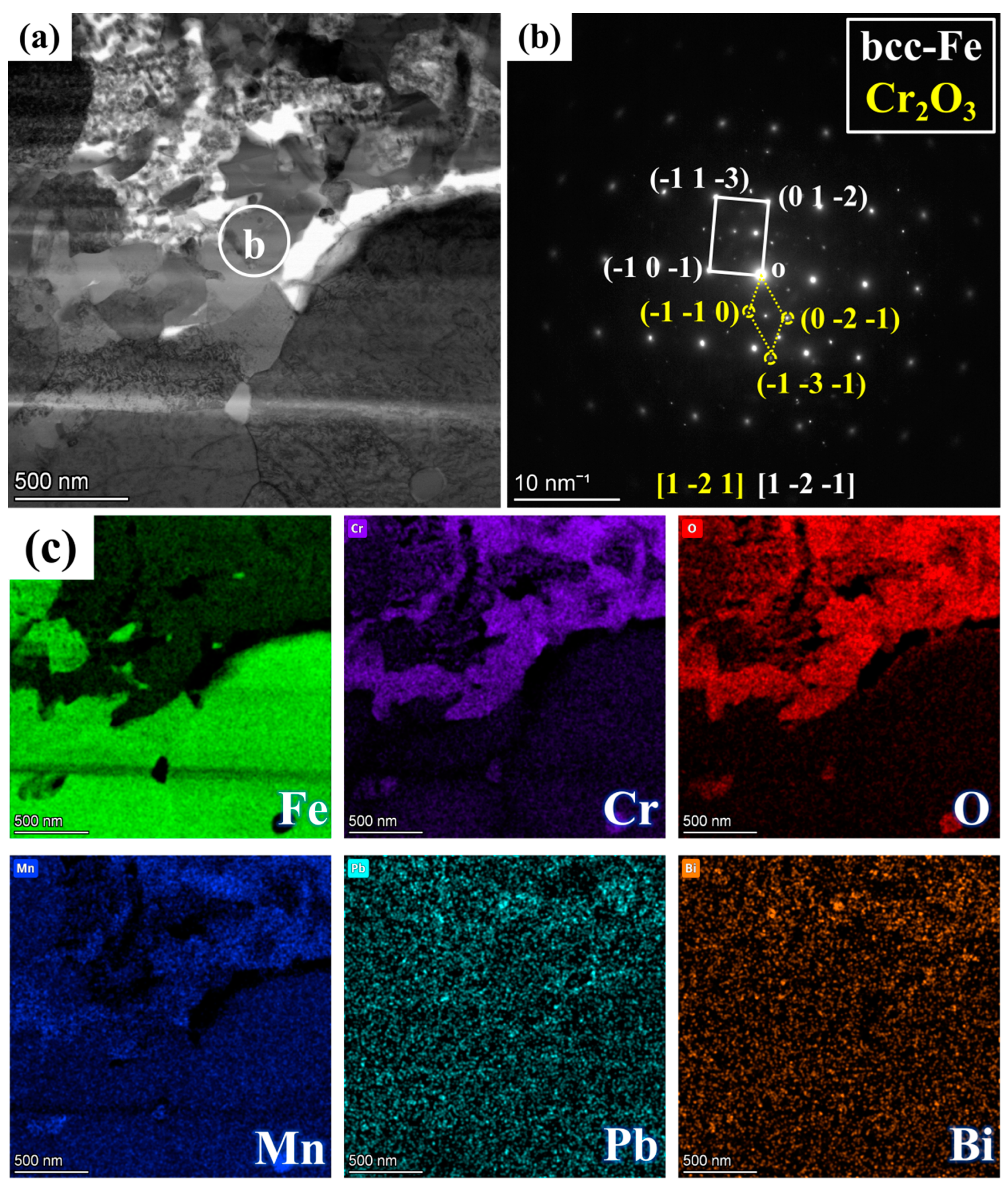
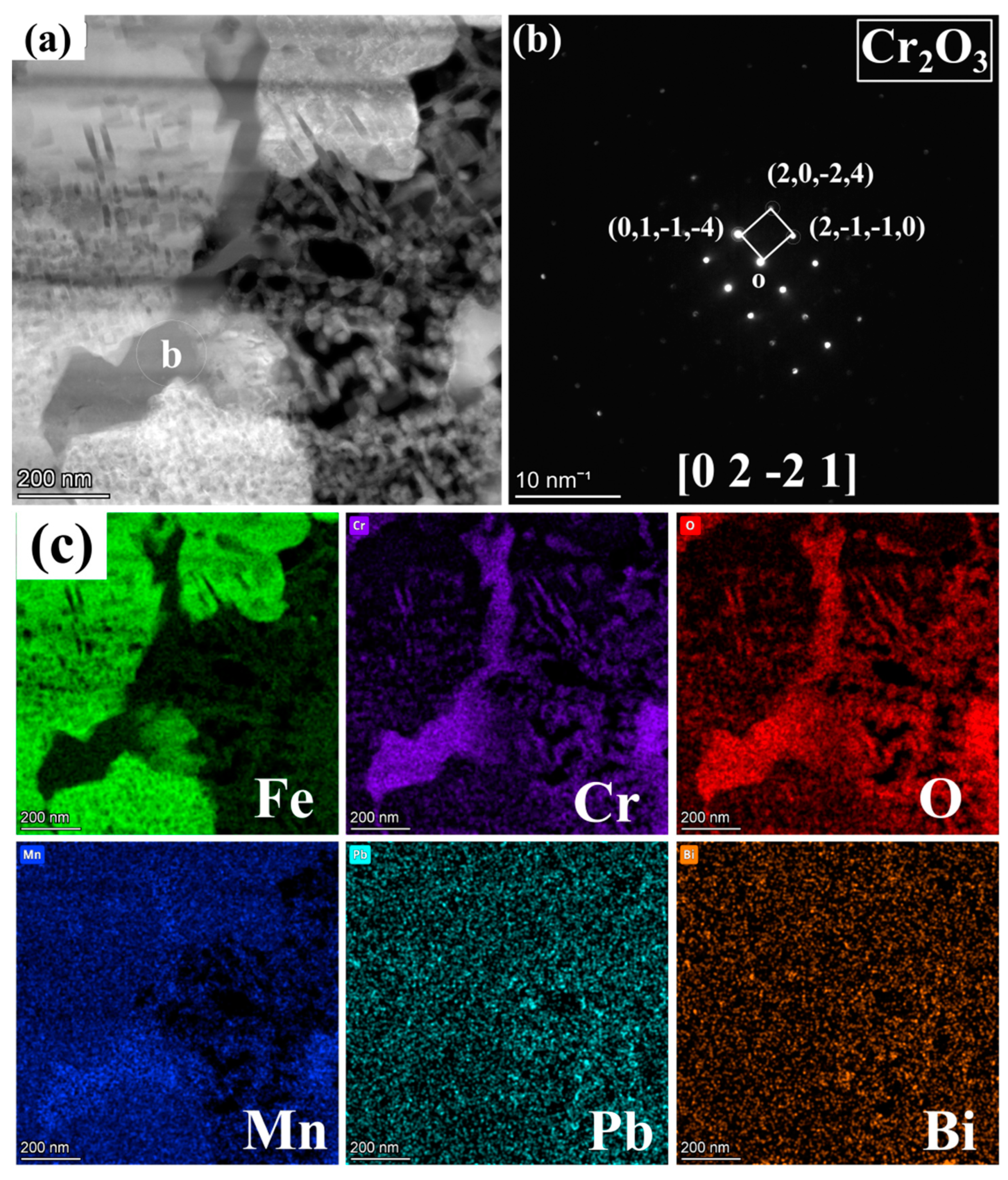


| Fe | Cr | Mn | N | W | Ta | V | Y | O | C | Si |
|---|---|---|---|---|---|---|---|---|---|---|
| Bal. | 8.82 | 0.96 | 0.12 | 0.99 | 0.097 | 0.39 | 0.21 | 0.16 | 0.011 | 0.009 |
Disclaimer/Publisher’s Note: The statements, opinions and data contained in all publications are solely those of the individual author(s) and contributor(s) and not of MDPI and/or the editor(s). MDPI and/or the editor(s) disclaim responsibility for any injury to people or property resulting from any ideas, methods, instructions or products referred to in the content. |
© 2025 by the authors. Licensee MDPI, Basel, Switzerland. This article is an open access article distributed under the terms and conditions of the Creative Commons Attribution (CC BY) license (https://creativecommons.org/licenses/by/4.0/).
Share and Cite
Yang, C.; Liu, T.; Yang, Y.; Wang, Y.; Xu, Y.; Yun, D.; Lei, P.; Qiu, J. Study on the Corrosion Behavior of Low-Carbon 9Cr-ODS Steel in Oxygen-Saturated Lead–Bismuth Eutectic for 1000 Hours. Nanomaterials 2025, 15, 258. https://doi.org/10.3390/nano15040258
Yang C, Liu T, Yang Y, Wang Y, Xu Y, Yun D, Lei P, Qiu J. Study on the Corrosion Behavior of Low-Carbon 9Cr-ODS Steel in Oxygen-Saturated Lead–Bismuth Eutectic for 1000 Hours. Nanomaterials. 2025; 15(4):258. https://doi.org/10.3390/nano15040258
Chicago/Turabian StyleYang, Chongdou, Tao Liu, Yiqun Yang, Youqi Wang, Yuwen Xu, Di Yun, Penghui Lei, and Jie Qiu. 2025. "Study on the Corrosion Behavior of Low-Carbon 9Cr-ODS Steel in Oxygen-Saturated Lead–Bismuth Eutectic for 1000 Hours" Nanomaterials 15, no. 4: 258. https://doi.org/10.3390/nano15040258
APA StyleYang, C., Liu, T., Yang, Y., Wang, Y., Xu, Y., Yun, D., Lei, P., & Qiu, J. (2025). Study on the Corrosion Behavior of Low-Carbon 9Cr-ODS Steel in Oxygen-Saturated Lead–Bismuth Eutectic for 1000 Hours. Nanomaterials, 15(4), 258. https://doi.org/10.3390/nano15040258








